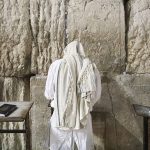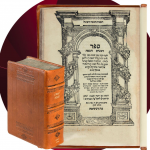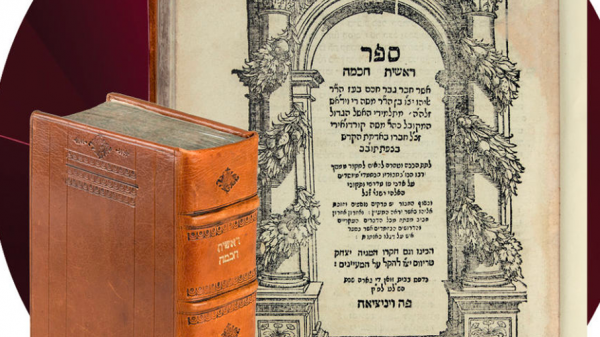Click here to download PDF
Who cares about a Rock’s parnassah?
In this week’s Parsha we have the incident of Moshe hitting the rock as opposed to speaking to it. This is what sealed his fate that he would not take the Jewish people into the land of Israel. Hashem says ”because you did not believe in me to sanctify me in the eyes of the children of Israel therefore you will not bring this assembly to the land that I gave to them” Rashi explains that the sanctification of Hashem in the eyes of the Jewish people that Hashem was referring was “If you would have spoken to the Rock and it would have brought forth water I would have been Sanctified in the eyes of the congregation and they would have said if this rock that neither speaks neither hears and does not require livelihood upholds the word of Hashem certainly so us” There are several seemingly superfluous points here: The fact that a rock neither speaks nor requires livelihood are totally aside from the point. The main point is that even though it is deaf it’s still upholds Hashem’s orders certainly us who can hear and obey. What do speaking and requiring livelihood have to do with anything?
Heaven & Earth vs the Rock
Contrast that with how Hashem drops a hint to the Jewish people about staying the course of Torah Mitzvahs from the heaven and earth. Rashi on the Pasuk (Devarim 30:19) “I’ll bring as Witnesses against you the Heaven and the Earth” says that Hashem was saying to the Jewish people: “Take a look at the heavens that I created to serve you, did they ever change their course? Has the sun ever failed to rise in the east and illuminate the whole world? Take a look at the Earth that I created to serve you, did it ever change its ways? Did you ever plant it and it did not grow? Or perhaps, have you ever planted wheat and it brought up barley instead? Just like these that were not created for reward and Punishment and if they do good they do not get reward and if they do wrong they do not get punishment, still they never change their ways. You, the Jewish people that if you are virtuous you get reward and if you sin you get punished, how much more so”. The argument for the “Kal v’chomer” by Heaven and Earth could easily have been applied to the rock also: The rock also was not created for reward and punishment and does not get reward and punishment and even so it obeyed the directive to give water how much more so the Jewish people who do get reward and punishment. Why is it that reward and punishment is not one of the elements of the “Kal v’Chomer” by the Rock? Why is the focus purely on The Rock’s self-sufficiency and inability to perceive and communicate?
The Baal HaTurim’s code
The confusion that agitated the Jewish people which in turn caused them to fight with Moshe was that with the passing of Miriam the miraculous well that was in a rock that traveled with them hid amongst other rocks. The people were complaining because they were bewildered as to from which rock will they get water. Moshe himself did not know which rock it was he was supposed to speak to, and this tense situation caused Moshe to be angry with the Jewish people. According to the Rambam in the 4th of his 8-chapter introduction to Avos Moshe’s anger with the Jewish people was the essence of his sin. After calling the Jewish people ‘rebels’ he asked rhetorically: “Hamin”-from this rock we will bring out water” meaning to say everyone was wondering which rock and Moshe says: “Do you think I would bring it from any Rock other than what Hashem wants”. The Baal HaTurim makes the word association that this statement for which Moshe was punished “Hamin” rings familiar with how Hashem chastised Adam after he ate from the Tree of knowledge by asking: “Hamin”- from this tree did you eat” What is the common denominator between theses two events that the Baal HaTurim is alluding to? Furthermore, the Gemara (Chullin 139) sees an allusion to Haman from the story of Purim in in that very word “Hamin” (spelled the same as Haman) used by Hashem when confronting Adam. What is the connection? Is there a connection to the event of Moshe hitting the rock in our parsha?
Hands up Hands Down
Rashi explains that because they didn’t know which rock to address they spoke to the wrong rock and Moshe thought back to a previous instance when he had to get water from the rock in parshas Beshalach where he had to hit it. By the time Moshe started hitting the rock the correct rock had already shifted into place, but it would not give water immediately, only after being hit twice, to teach Moshe that he was not really meant to hit the rock at all. That earlier incident of getting water from a rock was a state of confusion for the Jewish people who asked: “is Hashem in our midst or not”. In response Amalek came to fight with the Jewish people. So long as Moshe’s hands were up in prayer the Jewish people were victorious. As the Mishna () says Moshe’s hands raised reminded the Jewish people of Hashem and they subjugated themselves to Him. Moshe’s hands raised in prayer is summed up in the Torah as: “and his hands were “Emunah”-faith until the sunset” contrast that with this week’s Parsha where Moshe lowered his hands to hit the rock which Hashem criticized as: “you did not have “Emunah”-faith in me…”. What’s the connection between the hands and faith? The concepts of “hands” is at the essence of the issue. After the Jews express their doubt “is Hashem in our midst or not” the Torah says: “and Amalek came and fought with the Jews in Refidim” Chazal say that “Refidim” should be read as an acronym for “Rafu Yadayim”– their hands softened their grip on the Torah. The doubts they expressed is qualified as “softening of their hands’ grip on the Torah”. What does this all mean?
Giving the Torah revisited
The event of giving the Jewish people water in our parsha was something much bigger than all other times Moshe had to provide for the Jewish people in course of the 40 years in the desert. Signs that this would be a game-changing event can be seen from the prelude to the story. The Torah stresses that this is the generation that will enter land of Israel as the whole previous generation had died off. Miraculously the entire Jewish people were to be at this event even with their livestock. There is one event that was like that a generation earlier: the giving of the Torah. The Torah is compared to many things, one of which is water. Hashem refers to Himself as “the source of Life-Giving water”(), the “life-giving waters” that emanates from that “source” is the Torah. The generation that just had died out with the death of Miriam had this miraculous well as a manifestation of how that they are the generation that got the Torah. The Waters from the wells of Miriam represented how they were able to imbibe Torah and would sit well with them the same way water could be imbibed and then sit well in a person. What makes an idea ‘sit well’ with a person? Explaining it. The Hebrew word for explanation is “Be’er” which is the same word for “well”. The well of Miriam gave the people an understanding that allowed them to internalize the Torah and be one with it. History tells us that when Rav Chaim Vital was initially studying under the Arizal “the wisdom did not sit well with him” meaning that he was learning and not understanding, learning and forgetting. To remedy that problem the Arizal took him out in a little boat and they went out into the ocean to the place where the well of Miriam is hidden. The Arizal gave Rav Chaim Vital waters from that well and after that “the wisdom settled in him”.
The mouth from the twilight zone
With this we can understand what the Mishna in Avos means when it says “Pi HaBe’er”- the mouth of the well was created by in the “twilight zone” between Friday and Shabbos. The “mouth of the well” that allows access to deep waters is like the mouth that explains deep ideas. Torah was given on Shabbos as Torah is from the dimensions of Holiness, so it was revealed on the Holy day. There must be a bridge between the Holy that is beyond and the profane that is our world. The bridge in “time” is the function of the “twilight zone” between Friday and Shabbos. The bridge in human experience to connect the mortal mind with the depths of the Torah is the function of the “mouth of the well” that gives us access to the depths of Torah like the mouth of a good teacher gives explanations that allow the student to get a grasp (more on this soon) on deep ideas.
Heart of Stone
With the passing of Miriam, the generation that received the Torah at Sinai had passed on. Many of the next Generation may have been alive at the time of the revelation at Sinai but they were beneath the age of 20, and not considered as adult members of that generation. This new generation needs to receive the Torah again in preparation for their new world order in the land of Israel. It was up to Moshe to give them this water that represents a clarity and connection. If Moshe would have successfully created that bridge he would have merited to go with this generation into the land of Israel as the one who gave them their connection to Torah. The stone represented our hearts of stone, the ordinary earthly Stone of the second Luchos. The “mouth of the well” that “releases the waters” explains the Torah so it is understood and internalized. It’s not natural for Stone to give water and by the same token it is not natural for Mortal man to be have clarity in the supernatural Torah. The effect of this miraculous event upon the Jewish people would have been that by just speaking the words of Torah – like speaking to a rock – clarity would miraculously open up and pour forth – like getting a rock to give water in response to speaking to it. We would understand and produce Chidushei Torah in response to just saying the words of Torah.
Staying the Course vs the Supernatural
The Taking of the Heaven and Earth as Witnesses against us so that we should learn from them to ‘stay the course’ in our Mitzvah observance does not come close to what was being demonstrated here. Heaven and Earth are faithful to their natural course. The sun rises and shines and the Earth grows whatever was planted in it. To stay one’s natural course all you need is motivation. Hashem pointed out that Heaven and Earth stay on their natural course even without motivation and we who should be naturally adept at keeping Torah and Mitzvahs especially with the added advantage of the motivation of reward and punishment. However, no motivation in the world can help to do the supernatural. The Rock giving water was a supernatural event and it was about making a supernatural bridge between the mortal heart of stone and the Divine Torah. The message was: “Do not be disheartened by the limitations of mortal intelligence because a rock that could neither hear to absorb information, nor speak to ask or relay information, or require sustenance as it is totally dead still understood what it was told in the Name of Hashem (=Torah)- we that have the added advantage of having intelligence to absorb information, the ability to speak to ask and relay information, and our requiring sustenance shows that we are alive and have intelligence to procure that sustenance, how much more so that we can understand Torah”.
Hand – Mind connection
The great indicators as to whether ideas and values have been understood and internalized, and what those ideas are – are the hands. The mouth can easily ‘parrot’ the ideas but how we act upon the ideas is evidenced by our hands. All our productive work, our business dealings, are called “ma’aseh Yadayim” – the actions of the hands. When the mind is confused the hands cannot be productive in a sophisticated manner. In a state of confusion, the hands can only do simple movements like hitting. In parshas Beshalach the Jewish people fell into confusion and doubt (Safek) and questioned whether “Hashem is in their midst or not”. Moshe at that time was commanded to mirror the state of the people and hit the rock. That’s called that “their hands softened in their grip on the Torah” – to understand is called “to grasp” or “get a grip” in Hebrew we use the terms “Tefisa” – to grab or “Hasagah” – to reach/procure for understanding – because when you have clarity you use your hands productively and you don’t hit! The Jewish people fell into confusion, “their hands slipped from the Torah”, so Moshe mirrors their level by lowering his hands to hit the rock and they get punished with Amalek.
Amalek
Doubt and confusion are what the snake brought about for Adam and Eve when seducing them into eating from the Tree of knowledge. The “good versus bad mentality” has many gray areas, as “good” and “bad” are not absolute measures (see Rambam Moreh Nevuchim section 1 chapter 2). Amalek is a nation that brings confusion to the world so as to be able to rationalize any evil. That is why the numerical value of “Amalek” is the same as “safek”- doubt (240). This sheds light on why when Hashem confronts Adam for the sin that brought doubt and confusion to the world ‘rubs it in his face’ by ‘raising a question’ as if accentuating to Adam that as a result of eating from the Tree of knowledge of good evil he will be living with doubts. There and then dropping a hint to most notorious Amalekite of all time – Haman – to state that with this sin Adam gave rise to the greatest enemy of Hashem and the Jewish people. Whenever the Jews sink into doubt and confusion they are punished with Amalek the nation of doubt.
Emunah
There is a way to cope with confusion that is actually an elevating experience, it’s called “Emunah”- Faith. You leave it to Hashem, ‘hang tight’ and trust that all work out as Hashem pleases. With “Emunah” you actually raise your hands in submission and prayer to Hashem. Moshe was doing that for all the Jewish people, and they all strengthened their “Emunah” with Moshe’s hands raised. That was their “Tikun” for how they handled confusion – instead of falling into frustration they rose to faith and with that atoned for the confusion that brought Amalek – the nation of doubt and confusion.
Decoding the Baal HaTurim
In the event in our parsha there was a test to see how the Jewish people cope when seeking the clarity of Torah to escape confusion. Moshe was supposed to give them “Emunah” that no matter how limited the mortal heart of stone, they should trust that Hashem will always give them the clarity if they just start learning. But the Jewish people were confused which led to disgruntlement which led to frustration which led to anger. The ripple effect of that anger affected Moshe and got him angry and as Chazal tell us “when a person is angry if he is wise his wisdom leaves him, if he is a prophet is prophecy leaves him” Moshe reached fell into anger where his knowledge left him for a just a second and he said in that momentary confusion “Hamin” – from this rock? The Baal HaTurim was pointing out that momentarily Moshe fell into the confusion that anger brings, reminiscent of the confusion Hashem pointed out to Adam, and in that he hit the rock and that’s why learning Torah is not as easy as intended, and that’s why we forfeited having Moshe with us in Israel as he would have made learning Torah clear and easy.
Torah Today vs the Future
As a result of Moshe hitting the rock we attain clarity in Torah by “hitting twice”. It’s hard and frustrating work and you never get it right the first time. If you think you got it right the first time you are definitely wrong as one could see from any page of Gemara you need to go through multiple “Hava Minahs” until the “Maskanah”-final conclusion is reached. That is the nature of our Torah learning until after Moshiach comes and Moshe will lead us again (Medrash Rabba Haazinu) and restore the clarity of just speaking the words of Torah and our hearts will generate the waters of understanding and Clarity as the prophet says “and the earth will be filled with knowledge of Hashem like the waters covering the ocean”.









